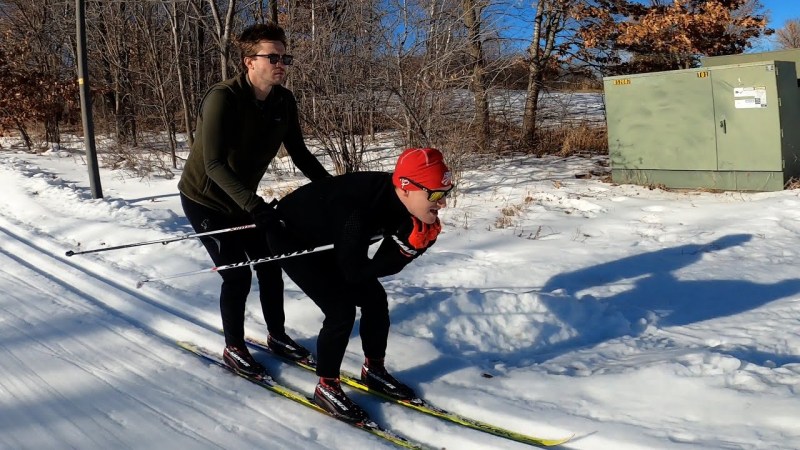The American Birkebeiner is the second largest cross-country skiing race in the world and is quite a big deal within that sport. At 55 kilometers it’s not a short event, either, requiring a significant amount of training to even complete, let alone perform well enough to be competitive. Around a decade ago, friends [Joe] and [Chris] ran afoul of the rules when [Joe] accidentally won the race wearing [Chris]’s assigned entry number, a technicality that resulted in both being banned from the race for two years. Now they’re back, having learned their lesson, and are strictly adhering to those rules this time using these tandem cross-country skis.
The idea for this build was to make sure they could both compete in the race and win because they’d compete in a category no one enters, mostly because it effectively didn’t exist before these two invented it. This required a custom set of skis, but since ski manufacturers don’t typically make skis for two people, they had to get creative. The duo picked up the longest pair of skis they could find at their local ski shop, moving the bindings forward on the skis to make room for the second set of bindings that were added to the back.
This presented a few unique challenges, the first of which is that cross-country skis typically use a special material on the bottom of the skis which grabs the snow to make uphill travel possible, and with the wider distribution of weight this material wasn’t functioning at peak efficiency. The other problem was the stress on the bindings caused by two riders, especially during a crash. This eventually resulted in a broken binding while [Joe] and [Chris] were training. They then upgraded to a more modern pair of skis rated for a single 269-pound rider, had the bindings fitted for two riders, and added a special grip tape over the larger area on the bottom of the ski.
After four months of training and getting in sync, the two were ready for the race. The results are covered in a second video linked below, and while neither of them won the overall race this time, they did finish the event with in-tact skis, first in the new “tandem” class, and completely within the bounds of the strict rules of the race as well. Although winter is winding down in the northern hemisphere, for any of our southern friends looking for some other things to do with an old set of skis for the upcoming winter season, take a look at this sled which adapts some alpine skis to achieve some extremely high speeds.















If they persisted with this, at least in traditional non-skate-ski categories, they could possibly do very well. Tandem bicycles in largely flat races are measurably faster than singles, and even in running, drafting plays a significant role.
Well they certainly look like they’re having “fun” in that picture, but I’m not one to judge.
55 kilometers is nothing in Finland. My parents skied to school that distance whole year round…
Uphill,
both ways!
In a snow storm!
And the family was so poor they had to share one ski.
Skis! We didn’t have skis. We took turns lying on our backs while the rest of the family stood on our bellies and pushed. We used the little ones as ski poles.
Ooh you were lucky. ’round where I was, it wasn’t cold enough so the little ones kept melting and we couldn’t use them as sticks. Didn’t have the snow either, we had to ski on gravel.
Luxury!
They look familiar… What was that SNL sketch?
You might be mixing up Dieter with Hans and Franz?
>cross-country skis typically use a special material on the bottom of the skis which grabs the snow to make uphill travel possible
A bog standard cross-country ski is just a ski though. You wax the bottom for better glide, except under the arcing part under your foot which is left dry and scuffed up with sandpaper, or covered in a more grippy wax – traditionally tar. If you pick the wrong wax for the type of snow, you’ll end up with either no grip whatsoever, or no glide, or so much grip you’ll be soon walking along with chunks of ice stuck to the bottom of your skis.
More recently, they’ve (re) invented the hairy bottom skis where you have a bit of synthetic “fur” under the foot for mechanical grip rather than adhesion. The fibers are swept back when gliding and bristle out when kicking. This mimics the stone-age version where they used a piece of moose or caribou pelt strapped under the ski.
Uphill skiing is also perfectly possible with no grip wax whatsoever: your static friction will always be slightly more than the gliding friction, although the difference may sometimes be very small. When the temperature rises towards melting, you get a film of water on the snow which makes it extra slippery. When the temperature is lower, you don’t necessarily need any grip wax to kick normally.
On steeper inclines, you switch to the skating style.
Almost forgot: grip tapes. That’s another version.
When I last CC-skied, the skis bottoms were smooth at either end, but the centers had many V-shaped wedges in them, with the V’s pointing forward. The V’s acted like one-way ratchets, where they would slide over the snow going forward, but grab into the snow when pushed back.